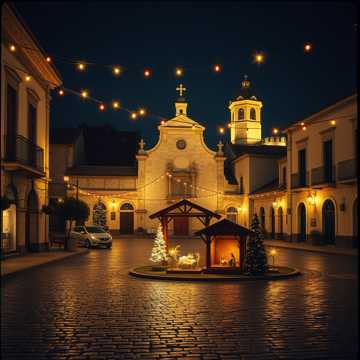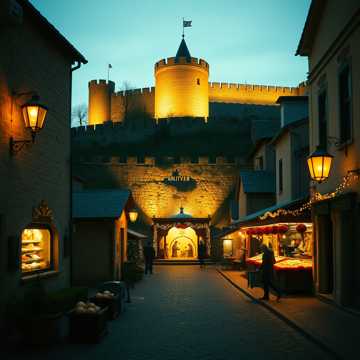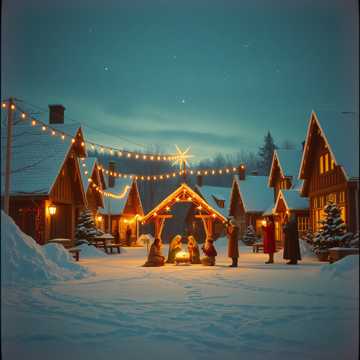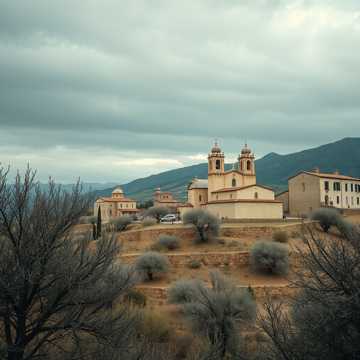
Free Spanish Folk Music Generator Powered by AI
Turn text into high-quality Spanish Folk music effortlessly – no login required!
music.toolTips

LA NAVIDAD EN SANTA GADEA DEL CID
A festive Spanish folk villancico celebrating Christmas in the village of Santa Gadea del Cid, highlighting community, tradition, and the spirit of unity and hope.
03:20
2 days ago

LA NAVIDAD EN SANTA GADEA DEL CID
A joyful Spanish folk villancico celebrating Christmas in Santa Gadea del Cid, highlighting community pride, traditions, and the spirit of togetherness, with wishes for peace, love, and happiness in the coming year.
03:06
2 days ago

echa v222
A lively Christmas song filled with joy, tradition, and warmth. With a female lead and vibrant choruses, 'Echa v222' captures the essence of family, peace, and celebration during the holiday season.
02:23
3 days ago

Villan
A protest-themed villancico, "Villan" intertwines Spanish folk music with fiery lyrics about workers’ rights, betrayal, and unity. It captures the struggles of laborers fighting for justice amidst corporate greed and false promises.
03:33
3 days ago

Cierzo en Valjunquera
A poetic journey through Aragón, 'Cierzo en Valjunquera' evokes the haunting, spiritual essence of the Cierzo wind, blending nature with the eternal and invoking the spirit of the land's past and present.
04:10
5 days ago
Introduction to Spanish Folk Music
Spanish Folk music is a rich and diverse genre that draws deeply from the cultural traditions of Spain. It encompasses a wide variety of regional music styles, each shaped by Spain's unique history, geography, and cultural influences. The origins of Spanish Folk can be traced back to ancient times, influenced by Roman, Moorish, and Jewish music, evolving through the centuries to become a central aspect of Spanish cultural identity. Folk music in Spain is often characterized by its expressive vocals, rhythmic complexity, and the use of traditional instruments such as the guitar, tambourine, and castanets. Over time, Spanish Folk music has become a dynamic and influential genre, with different regions of Spain contributing their own distinct sounds and traditions.
Sub-tags and Classifications of Spanish Folk Music
Flamenco
Flamenco is perhaps the most famous sub-genre of Spanish Folk music, originating from the Andalusian region of Spain. It is a passionate and emotional style, combining elements of song (cante), dance (baile), and guitar (toque). Flamenco music is known for itsSpanish Folk music overview intricate rhythms, powerful vocals, and distinctive handclaps and foot stomps that create a dramatic, intense atmosphere. Over time, Flamenco has evolved, incorporating influences from the Gypsy, Jewish, and Moorish cultures.
Fandango
Fandango is a lively and rhythmic folk dance and music style that has roots in various regions of Spain, particularly Andalusia. It is characterized by its upbeat tempo and syncopated rhythms, typically played on the guitar and accompanied by clapping or other percussion. Fandango music often features a call-and-response structure between the singer and the chorus, adding to its participatory and communal nature.
Jota
Jota is a traditional folk dance and music genre found in various regions of Spain, especially in Aragon, Castile, and Navarre. It is marked by its fast-paced tempo, often accompanied by castanets or other percussion instruments. The Jota is known for its lively rhythms and vibrant melodies, often expressing themes of romance, nature, and Spanish traditions.
Sardana
Sardana is a circle dance and music style native to Catalonia. It is performed to the sound of a brass band or cobla, which includes instruments such as the trumpet, trombone, and tuba. The Sardana is a symbol of Catalan identity and is characterized by its precise, structured steps, which emphasize unity and harmony as dancers form concentric circles and move in synchronization.
Famous Artists and Iconic Works in Spanish Folk Music
Paco de Lucía
Paco de Lucía was a virtuoso flamenco guitarist, widely regarded as one of the greatest guitarists of all time. His groundbreaking fusion of traditional flamenco with jazz and other contemporary genres revolutionized the genre. His albums, such as 'Siroco' and 'Almoraima,' showcase his technical brilliance and emotional depth. De Lucía's innovative approach to flamenco guitar has influenced countless musicians worldwide.
La Leyenda del Tiempo
'La Leyenda del Tiempo' is a landmark album by Camarón de la Isla and Paco de Lucía, released in 1979. This album marks a pivotal moment in the fusion of traditional flamenco with modern elements like jazz and rock. Its experimental sound, including electric guitar and synthesizers, was initially controversial but later recognized as a groundbreaking work that expanded the boundaries of flamenco.
Camarón de la Isla
Camarón de la Isla is often regarded as the most influential flamenco singer of the 20th century. His voice and unique approach to singing revolutionized flamenco, merging traditional styles with modern sensibilities. His collaborations with Paco de Lucía, particularly on the album 'La Leyenda del Tiempo,' are considered seminal works in the evolution of flamenco music.
Siroco
'Siroco' is one of Paco de Lucía's most celebrated albums, released in 1987. The album features a sophisticated blend of traditional flamenco with jazz and classical influences. De Lucía's virtuosity on the guitar is showcased throughout, and the album is often hailed as one of the greatest works in the flamenco genre. 'Siroco' was pivotal in elevating the international profile of flamenco.
Rosalía
Rosalía is a contemporary Spanish singer who blends flamenco with urban and pop music, bringing Spanish Folk to a new global audience. Her album 'El Mal Querer' showcases her innovative fusion of flamenco and contemporary genres, and she has become an international sensation. Rosalía's modern take on Spanish folk influences has reinvigorated the genre and expanded its reach.
Application Scenarios for Spanish Folk Music
Spanish Folk music is widely used in film soundtracks to evoke themes of passion, drama, and cultural heritage. The intense rhythms of flamenco and the soulful melodies of traditional Spanish folk songs are often used in films set in Spain or involving Spanish characters. Films such as 'Vicky Cristina Barcelona' by Woody Allen and 'The Flower of My Secret' by Pedro Almodóvar feature Spanish Folk music to enhance their emotional impact and cultural authenticity.
Movie Soundtracks
Spanish Folk music is frequently used in advertising campaigns to evoke a sense of tradition, warmth, and energy. Brands aiming to convey a connection with Spanish culture or heritage often use flamenco guitar or other folk styles to create a strong, evocative atmosphere. For example, commercials for food products or travel destinations in Spain may incorporate Spanish Folk music to attract and engage audiences.
Advertising Music
Spanish Folk music is sometimes used in video games, particularly those set in historical or culturally rich settings. The use of traditional instruments like the guitar or castanets can help immerse players in a game world inspired by Spanish culture. For example, games like 'Uncharted 3: Drake's Deception' feature Spanish-style music in sequences set in Spain, enhancing the player's experience of the game environment.
Video Game Background Music